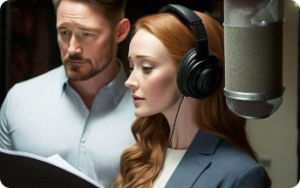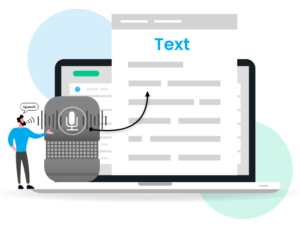Create or modify media
The use of technology to create or modify media, such as photos, videos, and audio, is known as synthetic media creation, sometimes known as artificial media. It is produced in large part thanks to AI, which has allowed for the advancement of cutting-edge methods including text-to-speech, speech-to-text, AI video production, and text-to-text translation. We will talk about the role of AI in the production of synthetic media in this blog article, as well as the advantages it offers the industry.
Synthetic media Creation Tools

Using AI algorithms, Text to speech for synthetic media creation technology, sometimes referred to as voice synthesis, transforms written text into spoken words. This technique has several useful uses, including enhancing accessibility for those who are blind and giving virtual assistants a voice that sounds more human. AI-powered text-to-voice software may also be utilized to provide unique and lifelike voiceovers for animations and films.
The capacity to produce incredibly lifelike and authentic-sounding voices is one of the major advantages of utilizing AI in Text to speech for synthetic media creation systems. Pre-recorded speech samples are used in conventional text-to-speech systems, and they might sound robotic and artificial. On the other hand, AI-powered systems may examine and replicate the features of a human voice, providing the listener with a more realistic and interesting experience.

Using AI algorithms, Speech to text for synthetic media creation technology, sometimes referred to as speech recognition, transforms spoken words into written text. This technology has a wide range of real-world uses, including as enhancing accessibility for deaf people and offering a quicker method of transcribing audio and video recordings. Subtitles for films and animations may also be produced with accuracy and dependability using AI-powered speech-to-text technology.
The capacity to accurately translate voice into text is one of the main advantages of utilizing AI in speech-to-text. The pre-programmed keywords and phrases used by conventional Speech to text for synthetic media creation systems might result in mistakes and inaccuracies. On the other hand, AI-powered systems can instantly evaluate and comprehend spoken language, producing a more accurate transcription.
Try Our Text to Speech Converter Now !
Create Content Effortlessly with CogniSpark Text to Speech Converter
Text-to-Text Translation

Text-to-text translation technology, also known as machine translation, is the use of AI algorithms to translate written text from one language to another. This technology has numerous practical applications, including improving communication and understanding between people who speak different languages.
One of the key benefits of using Artificial Intelligence in text-to-text translation is the ability to achieve a high degree of accuracy and fluency. Traditional text-to-text translation systems rely on pre-programmed keywords and phrases, which can lead to errors and inaccuracies. AI-powered systems, on the other hand, can analyze and interpret written language on the fly, resulting in a more accurate and fluent translation.
AI Video Generation

The use of Artificial Intelligence algorithms to create believable and coherent films from text or voice inputs is known as AI video generating technology. By enabling the automatic synthetic media for movies from a screenplay or voiceover, this technology has the potential to completely transform the way videos are produced.
The capacity to produce films considerably more quickly and cheaply is one of the main advantages of employing AI in video creation. Writing a screenplay, filming, and editing are all time- and money-consuming steps in traditional video production. On the other side, Artificial intelligence -powered video generation can automate much of this process, making it possible to make movies at a much quicker rate and for a significantly cheaper price.
Conclusion:
In conclusion, AI plays a substantial and positive role in the production of synthetic media. AI-powered methods for producing artificial media, such as text-to-speech, speech-to-text, AI video production, and text-to-text translation, are more effective and affordable. Additionally, AI-powered systems can provide accurate transcriptions, fluid translations, and voices that are incredibly realistic and natural-sounding, all of which enhance the user experience. Future uses of AI in the production of Synthetic media should become increasingly more cutting-edge and complex as technology develops.





















